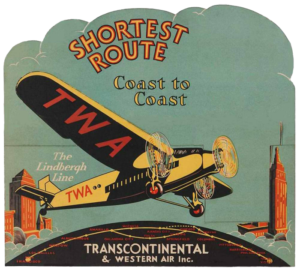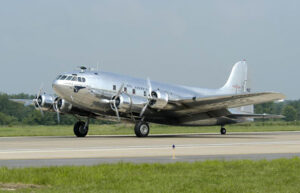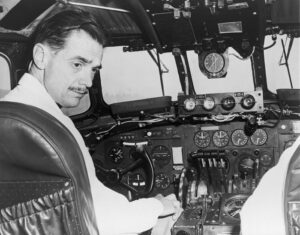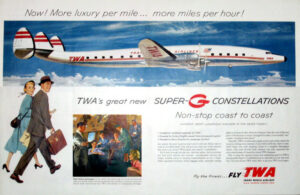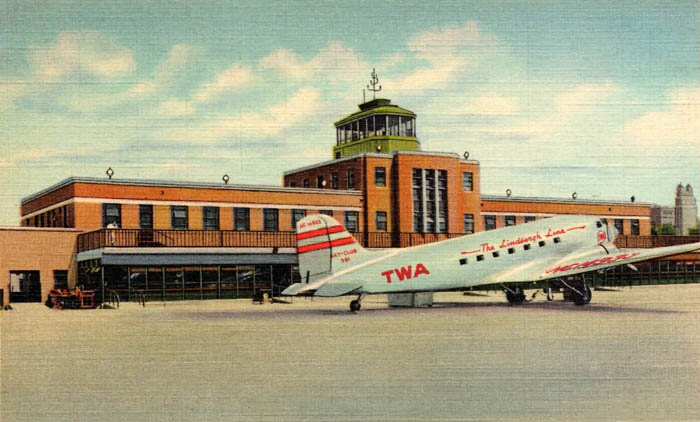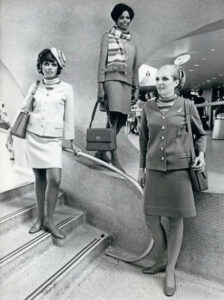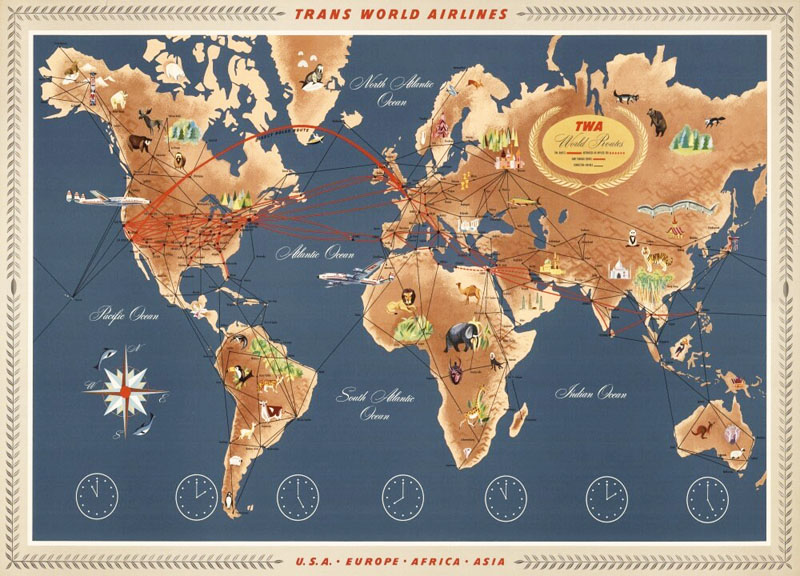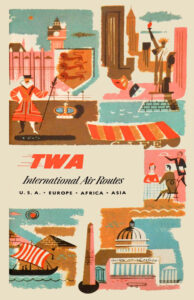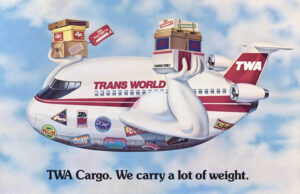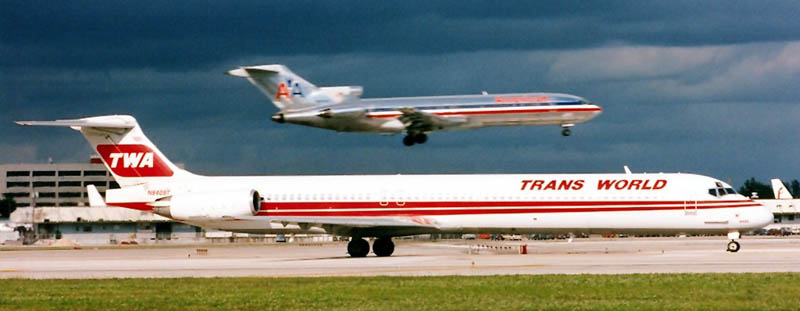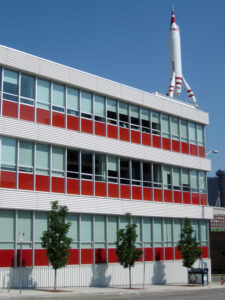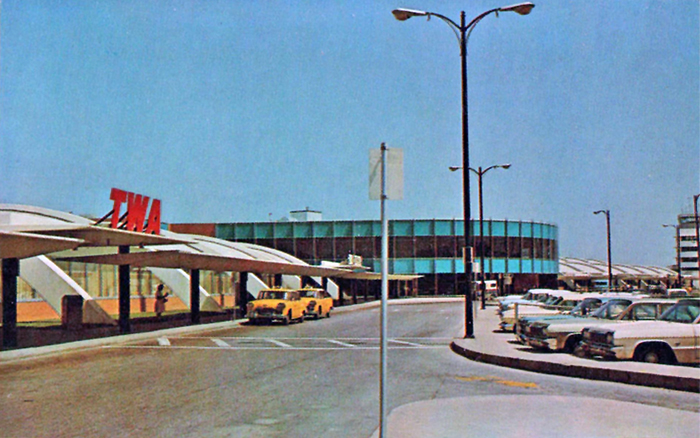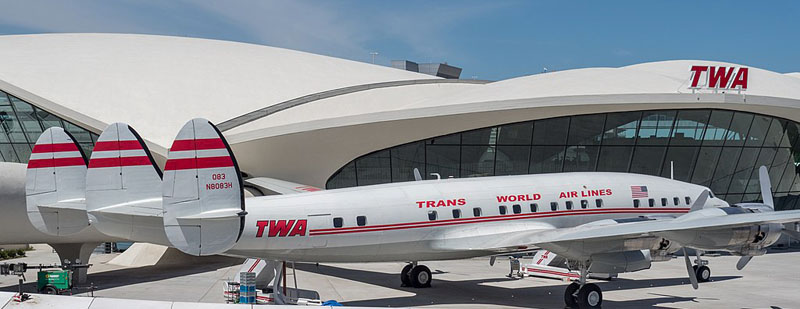
A retired airliner is used as a cocktail bar at the TWA Hotel at JFK Airport in New York City, photo courtesy Wikipedia.
Trans World Airlines, Inc. (TWA) was a former American airline that maintained extensive routes in the United States, Europe, the Caribbean, and the Middle East. It operated from 1930 until 2001, when it was absorbed by American Airlines.
TWA was established on July 16, 1930, as Transcontinental & Western Air to operate a route from New York City to Los Angeles, California, via St. Louis, Kansas City, and other stops. The company merged divisions of Western Air Express, founded in 1925, and Transcontinental Air Transport, founded in 1928. Western Air Express flew mail and passengers in its first year of service between Los Angeles and Salt Lake City, Utah, in 1926. Transcontinental Air Transport had a transcontinental network to get government airmail contracts.
The two carriers merged on the suggestion of the U.S. Postmaster General, who believed that two airlines, which both had government contracts to deliver airmail, should not operate identical routes while being paid by the government for such services.
TWA set up its headquarters in Kansas City, Missouri, on the recommendation of famed aviator Charles Lindbergh, who had been associated with Transcontinental Air Transport. The company’s first headquarters was in the Kansas City Municipal Airport, and additional offices were scattered throughout the city.
With American, United, and Eastern Airlines, TWA was one of the “Big Four” domestic airlines in the United States.
In 1930 TWA inaugurated coast-to-coast service — Newark, New Jersey, to Los Angeles, California, in 36 hours with a stopover in Kansas City, Missouri.
On March 31, 1931, the Transcontinental & Western Air Fokker F-10 crashed near Matfield Green, Kansas. The accident killed all eight on board, including University of Notre Dame football coach Knute Rockne. The cause of the crash was linked to the wooden wings, one of which failed in flight. Consequently, the airline’s Fokker F.10s were grounded and scrapped.
In 1934, Western Air Express became independent and was later called Western Air Lines. The same year, William John Frye became president of TWA. Only 30 years old at the time, Frye was a Hollywood stunt flier before working for the airline.
In 1938, Frye ordered the Boeing 307 Stratoliner and convinced the eccentric financier and aviation pioneer Howard Hughes to finance the purchase and invest in the airline. The following year, Howard Hughes acquired control of TWA.
After World War II erupted, TWA’s aircraft supported the U.S. military. After the war ended in 1945, the airline aggressively expanded and fought for market share against airlines such as American and United. It then became the second unofficial flag carrier of the United States after Pan Am.
In 1946, TWA introduced the Lockheed Constellation on its transcontinental New York-Los Angeles route. This was considered superior to United’s service, which utilized the DC-4. That year, TWA inaugurated international flights between New York City and Paris.
Frye and Hughes had a falling out in 1947. The airline was losing $20,000,000 a year and was in danger of not being able to acquire fuel for its planes due to being deeply indebted to oil companies. Making matters worse, the pilot’s union went on strike. Hughes provided $10,000,000 worth of financing, which was later converted to 1,039,000 shares. Frye was removed, and Hughes added 11 members to the board, giving him control.
“Frye’s inept handling of costs, his inefficient operations, his extravagance with new purchases of equipment, all these factors combined to nosedive the TWA stock from 71 at the war’s end to 9 in 1947.”
— Noah Dietrich, Hughes’s financial advisor
Until 1950, the carrier was known as Transcontinental & Western Air, Inc. Afterward, it was renamed Trans World Airlines.
In September 1952, TWA introduced the Lockheed L.1049 Super Constellation. Subsequently, on October 19, 1953, it became the first airline to inaugurate regularly scheduled, nonstop transcontinental service between Los Angeles and New York.
In the 1950s, the airline expanded its routes through Europe, the Middle East, Africa, and Asia.
In 1955, the company consolidated all its operations into one facility. A new headquarters building was constructed at 18th and Baltimore Avenue in Kansas City. The 124,000-square-foot building, covered in red and white metal paneling, TWA’s signature red and white corporate colors, was built for $1.5 million. The three-story L-shaped commercial facility was completed in October 1956.
A giant 22-foot-tall model rocket named the Moonliner II stood atop the corporate headquarters building. It was a 1/3 scale replica of another rocket, the Moonliner I, that stood in Tomorrowland at Disneyland in Anaheim, California. The Moonliner at Disneyland was sponsored by TWA from 1955 to 1962 and featured the company’s logo. After the partnership ended, the Moonliner II rocket was removed from the top of the building headquarters. It eventually ended up in the possession of Kansas City’s National Airline History Museum.
In 1961, Howard Hughes, TWA’s principal stockholder, lost control of the airline to a group of Wall Street banks and financial institutions that had financed the purchase of jet aircraft for the airline. An antitrust lawsuit was mixed in with complex civil litigation, and the multiple litigations involved repeated court hearings that the reclusive Hughes refused to appear. In 1966, Hughes sold his TWA shares for over $500 million.
Its main transatlantic hub was the TWA Flight Center at John F. Kennedy International Airport in New York City, an architectural icon completed in 1962.
By 1964, TWA had become a major international figure in aviation, which prompted the airline’s headquarters to move to New York City. The Kansas City headquarters building continued to house TWA’s accounting department, ticket office, credit department, cargo department, and flight attendant training until 1969. The airline later developed another domestic hub in St. Louis, Missouri.
Though most TWA operations ended in Kansas City in 1969, the Breech Academy, a training facility for train flight attendants, ticket agents, and even pilots, opened in the Kansas City suburb of Overland Park, Kansas. The three-building campus at 6300 Lamar Avenue was named for TWA executive Ernest R. Breech. Management training classes were held there for TWA employees, external managers, and prospective managers. The academy was so popular that other airlines sent their own flight attendants to the school. The academy continued to operate until 1988.
Throughout the 1960s and 1970s, TWA remained a powerful player in international and national markets. In 1961, it became the first airline to introduce in-flight movies. In 1967, the airline acquired the entire chain of Hilton Hotels and Century 21 Real Estate in an attempt to diversify the company’s business.
In July 1969, the airline officially beat Pan Am as the world’s number-one transatlantic airline. Less than a year later, in 1970, TWA would begin flying the Boeing 747 jumbo jet on its well-established New York-to-Los Angeles service.
From 1969 to 1975, TWA operated transpacific services and continued to be a round-the-world carrier. However, in 1975, it suspended these services in a route exchange with Pan American World Airways.
In 1978, the Airline Deregulation Act was passed, deregulating the airline industry in the United States and removing federal control over such areas as fares, routes, and market entry of new airlines. Though the Civil Aeronautics Board’s powers of regulation were phased out, the Federal Aviation Administration’s (FAA) regulatory powers were not diminished over all aspects of aviation safety. The Deregulation Act led to a wave of airline failures, start-ups, and takeovers as the carriers engaged in intense competition from other airlines while battling stiff operating costs.
TWA was reorganized under the ownership of a holding company called Transworld Corporation in 1979. In the meantime, the carrier had badly neglected domestic U.S. expansion at a time when the newly deregulated domestic market was growing quickly.
In 1984, Transworld sold TWA to the public while defending itself against a threatened hostile takeover. By then, TWA was experiencing financial troubles, and in late 1985, American investor Carl C. Icahn acquired the airline. In 1986, TWA bought Ozark Air Lines, Inc., a carrier with routes centered in the south-central United States. Under Icahn’s direction, its most profitable assets were sold to competitors.
In 1988, Icahn took TWA private, receiving $469 million in the deal – equivalent to $1.2 billion in 2023. The agreement also meant that TWA would take on $540 million in debt – $1.39 billion in 2023. In 1991, Icahn sold TWA’s coveted London routes to American Airlines for $445 million. Some believed that the loss of these valuable assets accelerated TWA’s demise. Although TWA continued to operate as usual, the company filed for bankruptcy to enable timely reorganization in January 1992.
A year later, in 1993, it emerged with 55% of the company under creditor ownership. Carl C. Icahn was himself a creditor and was owed $190 million. With TWA desperate to finish business with Icahn, an eight-year agreement allowed him to buy select tickets at 55% of the cost. Reselling the tickets on the internet, American Airlines estimated that $100 million per year was being lost because of the deal. Jeffrey H. Erickson took over as president in 1994, moved its headquarters to St. Louis, and sponsored the Trans World Dome.
TWA operated at a loss in the following years and went bankrupt in 1995. This would be followed by a tragic TWA explosion on July 17, 1996, killing 230 people on board. TWA’s worst accident occurred when Flight 800, a Boeing 747 en route to Paris, exploded over the Atlantic Ocean near Long Island. The flight was under the command of Captain Steven Snyder, a veteran TWA pilot. The National Transportation Safety Board concluded that the most likely cause of the disaster was a center fuel tank explosion sparked by exposed wiring. Subsequent media coverage focused heavily on TWA’s airline fleet, which was among the oldest in service. The 747 used for Flight 800 was manufactured in 1971, making it 25 years old at the time of the accident.
If that wasn’t enough, the late 1990s saw TWA stifled by the strong power of mechanics unions, which successfully resisted the closure of large and unnecessary maintenance bases. In Europe, labor laws meant TWA had to keep unnecessary workers employed.
“We had to either pay them forever or try to buy them out, which meant wages and salaries for the next 25 years. That made it extremely difficult to compete with the Continentals, Deltas, and Americans that were coming in, outsourcing labor.”
— Jack Stelzer, VP of Planning, TWA, 1997
In January 2001, it was announced that TWA was bankrupt for the third time and would be sold to American Airlines. After being in operation for 70 years, TWA ceased to exist as a separate airline in December 2001.
Having been in operation for over 70 years, the airline joined the company of Pan Am as an icon of America’s golden age of aviation and a pioneer of commercial passenger travel.
“American and United survived because they had iron-willed CEOs dedicated to being the number-one carrier. Ours were distracted…We were always known for coming up with little gimmicks like inflight movies, coffee, and [frozen] meals, but the big corporate decisions were lacking.”
— John Gratz, TWA pilot from 1955 to 1991 via St. Louis Magazine
In 2002, the Kansas City TWA building was added to the National Register of Historic Places. At that time, it had been vacant for several years, had fallen into disrepair, and TWA’s signature colors had been covered by stucco. In 2005, the Nicholson Group, a Kansas City-based urban development firm, began efforts to restore the building. Hiring El Dorado Architects, a $15 million project to refurbish the TWA headquarters into a modern office building began. The brown stucco was removed, and the original exterior was restored with a reproduction of the Moonliner II rocket. Since 2006, the building has been occupied by Barkley Inc., an advertising agency.
©Kathy Alexander/Legends of America, updated March 2024.
Also See:
Lost Landmarks and Vanished Sites
Sources:
Encyclopedia Britannica
Library of Congress
Simple Flying
The Clio
Wikipedia – TWA
Wikipedia – TWA Corporate Headquarters

